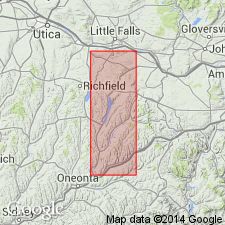
- Usage in publication:
-
- Cooperstown Shale Member
- Modifications:
-
- Named
- Dominant lithology:
-
- Shale
- Sandstone
- AAPG geologic province:
-
- Appalachian basin
Summary:
Pg. 12, 63 (table1), 88-91. Uppermost member of Moscow Formation in Cooperstown quadrangle is equivalent to Windom Shale. Name "Windom" has been applied at Cooperstown and as far east as Schoharie County, to interval of silty shales, siltstones, and sandstones of the Hamilton above Portland Point Limestone. This "Windom" bears little resemblance to typical calcareous shales of true Windom of central New York. Name Cooperstown is proposed for the eastern, coarser facies of the Windom. Consists of bluish arenaceous shales and fine-grained gray and brown argillaceous sandstones; fossiliferous. Thickness 410 to 460 feet. Overlies Portland Point Limestone Member; underlies Gilboa Formation. Boundary with Gilboa is essentially a faunal one. Recognized in east-central New York. Age is Middle Devonian (Erian Series).
Type section: composite sections along stream west of Platt Hollow Road and in Strong Ravine, 1 mi south and 2.7 mi south-southwest of Westville, respectively. Geographic extent of unit is from Cortland Co. to Schorharie Co., where it grades laterally into continental beds.
Source: US geologic names lexicon (USGS Bull. 1350, p. 170-171).
For more information, please contact Nancy Stamm, Geologic Names Committee Secretary.
Asterisk (*) indicates published by U.S. Geological Survey authors.
"No current usage" (†) implies that a name has been abandoned or has fallen into disuse. Former usage and, if known, replacement name given in parentheses ( ).
Slash (/) indicates name conflicts with nomenclatural guidelines (CSN, 1933; ACSN, 1961, 1970; NACSN, 1983, 2005, 2021). May be explained within brackets ([ ]).

